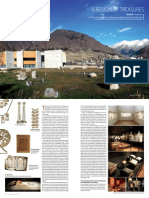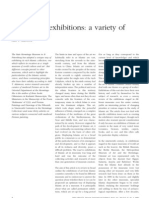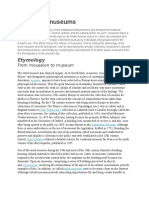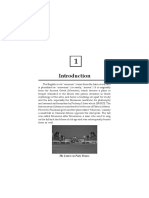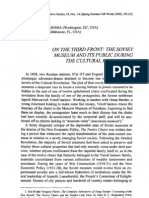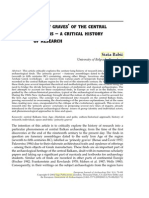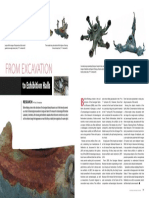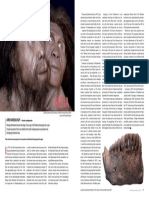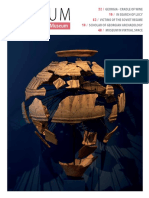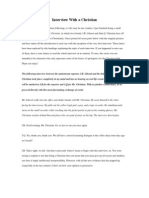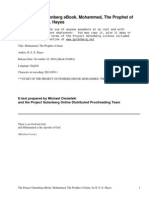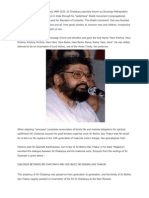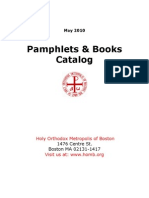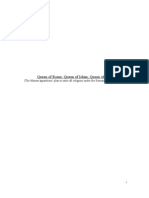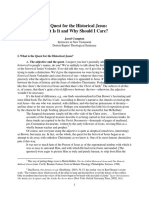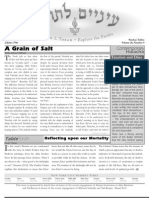0 ratings0% found this document useful (0 votes)
118 viewsRoots of The Georgian National Museum
Roots of The Georgian National Museum
Uploaded by
Georgian National MuseumThe educational component is
inherent to a museum. Creating
collections and protecting and
scientifically studying artifacts would
have partially lost their meaning if the
collective memory accumulated over the
centuries and carried by the items kept
in a museum remained out of reach for
the public. Even in pre-Christian times,
the role of rudimentary museums was
played by religious temples.
Copyright:
© All Rights Reserved
Available Formats
Download as PDF, TXT or read online from Scribd
Roots of The Georgian National Museum
Roots of The Georgian National Museum
Uploaded by
Georgian National Museum0 ratings0% found this document useful (0 votes)
118 views3 pagesThe educational component is
inherent to a museum. Creating
collections and protecting and
scientifically studying artifacts would
have partially lost their meaning if the
collective memory accumulated over the
centuries and carried by the items kept
in a museum remained out of reach for
the public. Even in pre-Christian times,
the role of rudimentary museums was
played by religious temples.
Original Title
Roots of the Georgian National Museum
Copyright
© © All Rights Reserved
Available Formats
PDF, TXT or read online from Scribd
Share this document
Did you find this document useful?
Is this content inappropriate?
The educational component is
inherent to a museum. Creating
collections and protecting and
scientifically studying artifacts would
have partially lost their meaning if the
collective memory accumulated over the
centuries and carried by the items kept
in a museum remained out of reach for
the public. Even in pre-Christian times,
the role of rudimentary museums was
played by religious temples.
Copyright:
© All Rights Reserved
Available Formats
Download as PDF, TXT or read online from Scribd
Download as pdf or txt
0 ratings0% found this document useful (0 votes)
118 views3 pagesRoots of The Georgian National Museum
Roots of The Georgian National Museum
Uploaded by
Georgian National MuseumThe educational component is
inherent to a museum. Creating
collections and protecting and
scientifically studying artifacts would
have partially lost their meaning if the
collective memory accumulated over the
centuries and carried by the items kept
in a museum remained out of reach for
the public. Even in pre-Christian times,
the role of rudimentary museums was
played by religious temples.
Copyright:
© All Rights Reserved
Available Formats
Download as PDF, TXT or read online from Scribd
Download as pdf or txt
You are on page 1of 3
established, such as the Caucasian Mu-
seum, the Museum of the Society for the
Spreading of Literacy, the Church Mu-
seum and the "Temple of Glory", which
was a Museum of Military History. Each
of these was created for different reasons
the Museum of the Russian Geographic
Society, the Caucasian Museum and the
Museum of Military History were esta-
blished to promote Russian policies and
values. However, others like the Museu-
ms of the Society for the Spreading of Li-
teracy and the Museum of the Georgian
Orthodox Church, were created by the
Georgian intellectuals to counterbalance
Russian values and culture, and to save
Georgian national treasures.
The Geographic Society Museum, ho-
wever, became the first complex scienti-
fic and educational institution in the Cau-
casus, and enriched its collections with
the contribution of private donations.
Significant among the items received by
this museum were ancient bronze figures
of a bellwether and goat heads brought
from Tusheti in 1863 and even a meteo-
rite that fell near Stavropol.
In the mid-19
th
century, naturalist and
archaeologist Friedrich Bayern made an
important contribution to the develop-
ment of museum work in Georgia, crea-
ting large natural science collections in
the Caucasus, which then became the
foundation for geological, zoological
and botanical collections of Tbilisi mu-
seums. To exhibit his rich collections, in
1856 Bayern opened a museum of natu-
ral sciences in Tbilisi's district of Didube,
which was called "Naturalist Bayern's
Office" then in 1859, Bayern began to
establish connections with the Caucasus
branch of the Russian Geographic Socie-
ty. He had become interested in the Urar-
tian cuneiform inscriptions discovered
near Ararat and in Georgia's archaeolo-
gical monuments. It was due to his ex-
ROOTS OF THE GEORGIAN NATIONAL MUSEUM
HISTORY > Ekaterina Gamkrelidze, Tamar Babuadze
"Any reasonable person understands easily howgreat an obligation the Museumwill have fromnowon. For a fundamental,
in-depth study of political, material and intellectual history, the broader public and especially students need museums
where everyone can see the material remains that are the physical expression of the history they read... The Museumof
Georgia is a grand establishment. One it has to portray past and modern culture and, to this end, collect artifacts and other
materials to ensure a comprehensive, scientific study of Georgia. Two it has a social obligation to help the public and,
especially, young students to enhance their knowledge of history. And three the Museumof Georgia, as the highest-level
scientific institution, should be conducting intensive scientific work."
On the main goals of the Museum, Ivane Javakhishvili, 1935
T
he educational component is
inherent to a museum. Creating
collections and protecting and
scientifically studying artifacts would
have partially lost their meaning if the
collective memory accumulated over the
centuries and carried by the items kept
in a museum remained out of reach for
the public. Even in pre-Christian times,
the role of rudimentary museums was
played by religious temples.
INITIAL OUTLINES
The pagan temples and chapels of the
Bronze and Iron Ages discovered in Eas-
tern Georgia, to which the population
donated ritual items for centuries, also
played the role of treasury. In the Medie-
val era, however, treasuries were set up at
the courts of the Georgian kings and ite-
ms of historical significance such as royal
jewelry and rare natural artifacts were
collected. The royal storehouse in Tbilisi,
at the court of David the Builder where
Vakhtang Gorgasali's armor and weapons
were kept, was an example. Churches and
monasteries had their own treasuries and
libraries. However, unlike royal treasuries
the items and manuscripts kept in spiritu-
al centers were studied closely.
Beginning with the 16
th
century, the
term "museum" derived from the An-
cient Greek, began to be used in Euro-
pe when referring to a storage place for
antiquities. For Georgia, it was an era of
declining statehood, which hampered
the development of museums. Only the
old-style royal salaros remained, safeke-
eping important items of natural history
and cultural heritage.
In the second half of the 19
th
century,
however, several museums opened in
Tbilisi. The first was a museum esta-
blished as the Caucasus branch of the
Russian Geographic Society in 1852.
Following this, similar institutions were
GEORGIAN NATIONAL MUSEUM 13
12
Eventually, the Russian Empire relinqui-
shed the implementation of their goal,
and in 1916, the doors of the "Temple of
Glory" closed never to open again.
THE "GEORGIAN MUSEUM"
By the late 19
th
century the Museum of
the Society for the Spreading of Literacy
was in its death throes and the Georgian
intellectuals realized that the Church
Museum alone would never be able to
collect, study and promote their national
treasures. Led by Ekvtime Takaishvili, in
1907 the Georgian Historical and Ethno-
graphic Society was established with the
goal to create a "Georgian Museum and
Library". For this purpose he managed
to unite illustrious Georgian personali-
ties such as Akaki Tsereteli, Vazha Psha-
vela, Iakob Gogebashvili, Vasil Barnov
(Barnaveli), David Kldiashvili, Ekaterine
cavations that Georgia's archaeological
antiquities became known to scientists
all over the world.
Three years after the exhibition ope-
ned, the Russian Geographic Society Mu-
seum administration decided to organi-
ze its first exhibition of these antiquities,
which caused great public interest. Ho-
wever, it was costly for the Geographic
Society to keep the Museum open and,
in 1864 the first Georgian museum clo-
sed, after only 12 years of existence.
THE CAUCASIAN MUSEUM
Yet soon after this another project was
submitted to the Viceroy's Chancellery by
an ethnographer of German origin, Gustav
Radde, to establish a Caucasian museum
where he could place his own materials
from the Caucasus as well as part of the
heritage left unattended after the closure
of the Geographic Society's Museum. In
1865, Radde's project was approved and
Radde himself was appointed Director. He
stated that fromthat point on, "the Cauca-
sus has become his precious and beautiful
second motherland."
There was a lack of Georgian items in
the Caucasian Museum, however occa-
sionally the collections were enriched by
significant local ethnographic materials
from Khevsureti and Abkhazia. In 1868,
the Caucasian Museum was merged with
the Public Library, and two years later, it
was moved to a new building with eight
exhibition halls, constructed by the ar-
chitect A. Salzman.
THE GEORGIAN MUSEUM FOR
EVERYONE!
In 1885, an "Archaeological" Museum
was established in connection with
the Library of the Society for the Spre-
ading of Literacy. Its collections were
gradually enlarged by significant ar-
chaeological, numismatic and historical
contributions. In 1907, according to Ilia
Chavchavadze's will, all of his property,
personal belongings and an exceptio-
nally rich library were bequeathed to
the Society for the Spreading of Literacy.
However, the Museum experienced gre-
at hardships as constant problems of
space meant that artifacts were kept in
different places. The philanthropist Da-
vid Sarajishvili had offered to sponsor
the construction of a large Museum, ho-
wever he died in 1911. As World War I
and global turmoil thwarted any plans
to build the museum, it also meant the
disappearance of the Society for the
Spreading of Literacy.
THE CHURCH MUSEUM
Meantime, in 1888, a "Treasure House
for Ancient Church Artifacts" had been
established in a building constructed es-
pecially for this purpose. The main merit
of the Church Museum, apart from sa-
ving threatened Georgian Orthodox tre-
asures, was the organization of special
expeditions. In 1889, expeditions were
organized to Mtskheta and David Gareja
which meant that important antiquities
were moved to the Tbilisi-based Church
Museum from these two centers of Or-
thodox Christianity. Other treasures were
collected from the Gelati, Samtavro and
Sokhumi churches.
Ten years later the Church Museum
had become a very strong institution,
with collections rivaling those of the
Caucasian Museum, and a total of 1,359
artifacts. However the Church Museum
was closed after Soviet rule was establi-
shed in Georgia in the first part of the 20
th
century.
THE "TEMPLE OF GLORY"
The idea of establishing a Museum of
Military History, or "Temple of Glory", in
Tbilisi was developed by the Director of
the Caucasian Museum, Gustav Radde in
1888. Originally to become the "Temple
of Glory" for the Russian Empire, it was
built in Alexander's Garden in the center
of Tbilisi. Renowned painters from all over
the Empire, including Franz Roubaud,
Max Tilke, Ivan Ayvazovsky and others,
were invited to illustrate the exhibition
and paint the battle scenes. While items
were being collected for the "Temple of
Glory" exhibition halls, it was possible to
organize other exhibitions with the parti-
cipation of Georgian artists. Thus, works
by Gigo Gabashvili, Aleksandre Mre-
vlishvili, Mose Toidze, Iakob Nikoladze
and others were exhibited for the first
time in Tbilisi. As a result, the "Temple of
Glory" became central to Tbilisi's cultural
life in the 1890s, a place where the Tbilisi
public could see the works of Georgian
artists for the first time. The "Temple of
Glory" was perceived more of a place de-
dicated to visual arts than an illustration
of the Russian Empire's military triumphs.
Gabashvili as well as Zakaria Paliashvili,
Ivane Javakhishvili and Niko Marr.
The Society received permission to
build a new museum in 1912, although
the Georgian Museum had been establi-
shed earlier. Of special significance for
the museum were the two manuscripts
donated to its first collection by Ekvtime
Takaishvili in 1908 the Book of Laws
and the Code of Vakhtang VI. In the follo-
wing years, in order to enrich their col-
lections, the museum's staff organized
expeditions, which meant they could or-
ganize two exhibitions in the building of
the Gymnasium for Noblemen.
David Sarajishvili had bequeathed
100,000 rubles for the construction of a
museum building and his widow added
600,000 to this amount but in vain with
the beginning of World War I, plans for
an appropriate building for a museum
were delayed again, and in 1927, hope
disappeared completely, and all collec-
tions and the library were taken over by
the Museum of Georgia, established in
connection with the Caucasian Museum.
THE MUSEUM OF GEORGIA
By establishing the Museum of Geor-
gia, one of the most important landma-
rks in the scientific study of Georgian
history began. In 1919-1920 the Gover-
nment of the Georgian Republic issued
several important decrees which, for the
first time, defined the system of Georgian
museums as a national institution. The
Museum of Georgia became a center of
supervision and protection of material
cultural monuments. In April 1920, a
Foundation for Purchasing Items of His-
torical Significance was established un-
der the Museum of Georgia. During the
Ethnographic exhibition hall of the Caucasian Museum
Ethnographic exhibition hall of the Caucasian Museum
GEORGIAN NATIONAL MUSEUM 15 GEORGIAN NATIONAL MUSEUM 14
same period, the periodicals "Sakartve-
los Muzeumis Moambe" (Bulletin of the
Museum of Georgia) and "Sakartvelos
Muzeumis Shromebi" (Proceedings of
the Museum of Georgia) were created.
A decree issued on 30 March, 1920
by the Constituent Assembly and the
Government on the establishment of
the Georgian National Art Gallery was
significant, as it founded Georgia's Mu-
seum of Art. Funds were also allocated
for the construction of a building for the
Museum of Georgia, although this was
never implemented. Because of the cha-
otic political situation that took over the
country, the Museum ceased its work
in accordance with an order issued on
20 February, 1921. However, several
months later the process of reviving the
Museum of Georgia began again, albeit
with difficulty. During this troubled pe-
riod, an Academic Council supervised
the work of the Museum, yet in 1921 all
the Museums relations and ties with fo-
reign scientific institutions were termi-
nated, and museum staff was frequently
targeted by Soviet Government repres-
sions.
In early 1922, the Government raised
the issue of repatriating Georgian anti-
quities kept in the Russian museums and
storage facilities. The process of repatria-
tion began a year later, with the involve-
ment of most of Georgias distinguished
academics and representatives of the
public. Although it proved impossible
to repatriate all items, as some of them
could not be traced, the search and at-
tempts to repatriate them continued for
a long time.
In 1923, the Soviet Government issued
an official decree, according to which the
reorganization of the museums had to
be conducted, yet the process was never
completed. As a result, Georgias museu-
ms decayed into terrible condition, some
even without buildings. The Republic's
Government closed them all, and be-
tween 1928 and 1931, all of the museum
collections of the Republic were placed
in the Museum of Georgia.
In 1929, the construction of a mu-
seum building in Tbilisi was comple-
ted, so that after a 30-year involuntary
hiatus the Museum finally regained
its main function organizing exhi-
bitions. In 1931, Ivane Javakhishvili
began working in the Museum and in
1937 he was appointed Head of the
History Department that he had been
earnestly trying to establish since
1934. With the Museum staff he devi-
sed projects and took on the training
of young scholars, intensifying work
on exhibitions, recording collections
and other tasks.
A physical-chemical restoration la-
boratory was founded in 1932, where
the refurbishment of metal items and
the restoration and conservation of an-
cient palimpsests were carried out. The
Museum's taxidermy laboratory was
outstanding, not only at the Georgian
level but compared to others in the So-
viet Union. In May 1933, scientific divi-
sions were established in almost every
department, with the participation of all
the Georgian scholarly elite. Thanks to
the scientists working at the Museum,
the institution received international re-
cognition yet because of limited fun-
ding, exhibitions could not be organized
simultaneously for all departments. In
1928, a zoological exhibition was orga-
nized and remained open until 1972.
Between 1931 and 1937, the halls offe-
red ethnographic exhibits of 18
th
-19
th
century Georgian garments and crafts
from Khevsureti and Svaneti; the so-cal-
led "vault" of the Department of Manus-
cripts; Georgian mineral resources; and
an exhibition displaying material culture
from the era of Shota Rustaveli. The sto-
rage facilities of the Museum's Library
were becoming richer every year and by
1932 there were 300,000 books in the
Museum Library.
Political events and repressions that
unfolded at the end of the 1930s left an
appallingmarkonthelifeof theMuseumof
Georgia and its scientists. In October 1933,
Giorgi Mirotadze became the Director of
the Museum, and then lost his life during
the repressions. Even so, the Museum's
institutional development continued, and
during this time large-scale archaeological
excavations began in Mtskheta, Samta-
vro and Armaziskhevi, Bolnisi and ancient
Dmanisi settlements, Gudarekhi and other
sites. The Museum of Georgia was given
the responsibility to process all of the dis-
coveries.
In 1926-1930, relations were re-establi-
shed with foreign scientific centers. In 1929,
the Museum broadened the scope of its
exhibitions abroad, and in June-October
1930, Germany's cities of Berlin, Cologne,
Nuremberg and Munich hosted an exhibi-
tion of ancient Georgian works of art , and
acataloguewas publishedinGerman. From
Germany, the exhibition traveled toVienna.
However, upon an order of the Soviet Go-
vernment on 25 May, 1938, the Museumof
Georgia consultant and world-renowned
scholar GrigolTsereteli wasarrested. Hedied
in prison. One year earlier, another great
scholar, folklorist Vakhtang Kotetishvili had
been executed. Then, a Government Order
No 2, declared that photos of "enemies of
thepeople" and"Trotskyitesaboteurs" were
toberemovedfromtheMuseum'sphotola-
boratory and handed over to the NKVD. As
aresult of thesemeasures manydocuments
andremarkablematerials disappearedfrom
Georgias archives.
When World War II began in 1941 the
Museum found itself threatened. In 1942,
Germans were succeeding on battlefiel-
ds and their troops approached the Cau-
casus. This led to the implementation of
special measures at the Museum. The
collections were placed in evacuation
crates and evacuation item lists made,
and removed to unknown sites. These
Caucasian Museum
collections were returned to the Museum
only in 1943. On 11 April 1945, some Ge-
orgian treasures that had been moved to
Paris returned to Tbilisi. The crates were
brought from the airport to the Museum
of Georgia, and under the supervision of
academician Simon Janashia, a govern-
ment commission was established, whi-
ch spent almost two years recording and
checking the items.
After Janashias death in 1947, the Mu-
seum was named after him.
In the 1950s, the Archaeology Depart-
ment was created as a separate division.
The number of archaeological expedi-
tions increased and collections became
richer. In 1957, a vault was built for the
most precious items illustrating the his-
tory of the development of Georgian
goldsmithery, and then in 1960 a lan-
dmark archaeological exhibition broke
the mold in Georgian exhibition work.
Through a vast array of archaeological
discoveries, visitors could discover a
complete picture of the history of Geor-
gian material culture from the Stone Age
Zoological exhibition hall of the Caucasian Museum
until the 4
th
century. In 1963-1981, there
was an exhibition of Georgian material
culture from the 4
th
to the 13
th
centuries.
In 1967 an exhibition entitled The Era of
the Bourgeoisiecompleted the series on
Georgian material history. So, the visitors
could follow the uninterrupted history
of Georgia from ancient times until the
Medieval Period and see the thematic
ethnographic exhibitions and treasure
exhibitions.
During the period of Soviet rule and
since that time, the Museum has re-
mained Georgias main institution for
science and exhibitions and a guarantor
for the protection of Georgian national
identity. Since 2004, after the establish-
ment of the Georgian National Museum,
the Simon Janashia Museum of Georgia
became its key component.
The article is based on G. Chkhaidze's mono-
graph "The State Museum of Georgia", Tbilisi,
2003; further reference: L. Chilashvili's article
"Looking Back 150 Years", Museum Anniversary
Bulletin, 2002, No 44.
GEORGIAN NATIONAL MUSEUM 17 GEORGIAN NATIONAL MUSEUM 16
You might also like
- G. Lewis The History of MuseumsDocument19 pagesG. Lewis The History of MuseumsManos Tsichlis100% (2)
- Svaneti Museum CatalogueDocument1 pageSvaneti Museum CatalogueGeorgian National Museum100% (1)
- National Archaeological Museum, AthensDocument176 pagesNational Archaeological Museum, Athenslouloudos1100% (9)
- Museum and Museum Libraries History and EvolutionDocument103 pagesMuseum and Museum Libraries History and EvolutionMohammad RehanNo ratings yet
- Gold! Divine Light and Lustre in Ancient MesopotamiaDocument25 pagesGold! Divine Light and Lustre in Ancient MesopotamianinzuNo ratings yet
- Collecting the New: Museums and Contemporary ArtFrom EverandCollecting the New: Museums and Contemporary ArtRating: 4.5 out of 5 stars4.5/5 (2)
- Georgia The Cradle of ViticultureDocument3 pagesGeorgia The Cradle of ViticultureGeorgian National MuseumNo ratings yet
- HOPKO. 2006. Christian Faith and Same-Sex Attraction - Eastern Orthodox Reflections (Sermons)Document13 pagesHOPKO. 2006. Christian Faith and Same-Sex Attraction - Eastern Orthodox Reflections (Sermons)B_The_Resourcerer100% (1)
- History of Christian Muslim Relations PDFDocument225 pagesHistory of Christian Muslim Relations PDFvandalashah100% (3)
- A Region of TreasuresDocument2 pagesA Region of TreasuresGeorgian National Museum100% (1)
- Jewish Cultural HeritageDocument4 pagesJewish Cultural HeritageGeorgian National MuseumNo ratings yet
- Remembering Ekvtime TakaishviliDocument3 pagesRemembering Ekvtime TakaishviliGeorgian National MuseumNo ratings yet
- The Role of Museums and The Professional Code of Ethics: Geoffrey LewisDocument16 pagesThe Role of Museums and The Professional Code of Ethics: Geoffrey LewisDan Octavian PaulNo ratings yet
- Permanent Exhibitions: A Variety of Approaches: Adel T. AdamovaDocument7 pagesPermanent Exhibitions: A Variety of Approaches: Adel T. AdamovabaskhanovaNo ratings yet
- Guida Commerciale WebDocument51 pagesGuida Commerciale WebAl-Najar SamerNo ratings yet
- Museum and Museology NOTESDocument9 pagesMuseum and Museology NOTESprabhakaru71No ratings yet
- British Museum, London (Great Museums of The World - Art Ebook)Document176 pagesBritish Museum, London (Great Museums of The World - Art Ebook)alina_peres24100% (9)
- The Role of Collectors in The Establishment of Museums (In The Case of Tashkent City)Document4 pagesThe Role of Collectors in The Establishment of Museums (In The Case of Tashkent City)Research ParkNo ratings yet
- Iraq Museum GUIDEDocument80 pagesIraq Museum GUIDEbaguenara100% (1)
- Cooperation With Georgia's Regional MuseumsDocument4 pagesCooperation With Georgia's Regional MuseumsGeorgian National MuseumNo ratings yet
- Museum Entrance: MuseumsDocument14 pagesMuseum Entrance: MuseumsVasix ZoltanNo ratings yet
- Gandhian From The History of Collections of The Cultural Heritage of Uzbekistan AbroadDocument7 pagesGandhian From The History of Collections of The Cultural Heritage of Uzbekistan AbroadresearchparksNo ratings yet
- The History of MuseumDocument19 pagesThe History of MuseumLoan ÁnhNo ratings yet
- Muzeele Din Moldova....Document7 pagesMuzeele Din Moldova....Cristina SadoveiNo ratings yet
- History of MuseumsDocument6 pagesHistory of MuseumsKing MughalNo ratings yet
- Museum PDFDocument317 pagesMuseum PDFPurba MukherjeeNo ratings yet
- ASH_V4_N3_006Document6 pagesASH_V4_N3_006shashwatimmortal11No ratings yet
- Historyof MuseumDocument13 pagesHistoryof MuseumaNo ratings yet
- 45 Years of Thracology in BulgariaDocument14 pages45 Years of Thracology in BulgariaⰒⰅ ⰕⰡ ⰅⰂⰔ ⰕⰀ ⰕⰋⰅѵⰀNo ratings yet
- Iraq Museum 2008Document80 pagesIraq Museum 2008PINAR GÜNAYNo ratings yet
- Qué Es Un Museo - GrisDocument8 pagesQué Es Un Museo - GrislauraNo ratings yet
- Georgian Embroidery and Textiles CollectionDocument2 pagesGeorgian Embroidery and Textiles CollectionGeorgian National MuseumNo ratings yet
- History of Museums, History of The Institutions That Preserve and Interpret The Material Evidence of TheDocument2 pagesHistory of Museums, History of The Institutions That Preserve and Interpret The Material Evidence of TheVirat GadhviNo ratings yet
- Museum Studies Week 2 2023Document47 pagesMuseum Studies Week 2 2023f4f9svq77xNo ratings yet
- Reserchers in IBERIA - COLCHOLOGYDocument345 pagesReserchers in IBERIA - COLCHOLOGYGeorgian National Museum100% (1)
- Israeli Museums MidtermDocument3 pagesIsraeli Museums MidtermAubrey CarrNo ratings yet
- Solovyov ADocument10 pagesSolovyov ANicolae Ion CatalinNo ratings yet
- Svaneti MuseumDocument4 pagesSvaneti MuseumGeorgian National MuseumNo ratings yet
- A Nex Turn in Russian EthnographyDocument21 pagesA Nex Turn in Russian EthnographyLoïc JhengNo ratings yet
- Kłudkiewicz - Regional Identity and National Identity, Prussia HebungspolitikDocument19 pagesKłudkiewicz - Regional Identity and National Identity, Prussia HebungspolitikglobalshiffftNo ratings yet
- Museum International: Islamic CollectionsDocument60 pagesMuseum International: Islamic CollectionsAhmad Jawad NiaziNo ratings yet
- Achaemenid Culture and Local Traditions in Anatolia, Southern Caucasus and Iran. 2007Document177 pagesAchaemenid Culture and Local Traditions in Anatolia, Southern Caucasus and Iran. 2007Denis Topal100% (4)
- Muzeul SatuluiDocument2 pagesMuzeul SatuluiRoxana AndreeaNo ratings yet
- The Development of Idea of Museum in The Indian ContextDocument6 pagesThe Development of Idea of Museum in The Indian ContextShruti Jain100% (1)
- Museum: From Wikipedia, The Free EncyclopediaDocument14 pagesMuseum: From Wikipedia, The Free Encyclopediasujit46No ratings yet
- Palestinian Museums PDFDocument1 pagePalestinian Museums PDFdhatuqaNo ratings yet
- On The Third Front: The Soviet Museum and Its Public During The Cultural RevolutionDocument18 pagesOn The Third Front: The Soviet Museum and Its Public During The Cultural RevolutionmadzoskiNo ratings yet
- State program "Мәдени мұра" - "Cultural Heritage"Document4 pagesState program "Мәдени мұра" - "Cultural Heritage"HissmatNo ratings yet
- Queer in The Museum Methodological Reflections On Doing Queer in Museum CollectionsDocument25 pagesQueer in The Museum Methodological Reflections On Doing Queer in Museum CollectionsTicking DoraditoNo ratings yet
- Princely GravesDocument19 pagesPrincely GravesNevenka Mandragora AtanasoskaNo ratings yet
- Museum Ras - ChroniclesDocument11 pagesMuseum Ras - ChroniclesAlmedin CuricNo ratings yet
- Traditional Jewelry of Uzbek Women-In World-Famous Museum ArtifactsDocument5 pagesTraditional Jewelry of Uzbek Women-In World-Famous Museum ArtifactsResearch ParkNo ratings yet
- JWeekly: Magnes Opus. Museum Springs Back To Life With New Berkeley Facility - 12.08.2011Document4 pagesJWeekly: Magnes Opus. Museum Springs Back To Life With New Berkeley Facility - 12.08.2011magnesmuseumNo ratings yet
- Museología - Inv #1Document7 pagesMuseología - Inv #1ツ・ ガブソクキムNo ratings yet
- Archaeological Museums of PakistanDocument16 pagesArchaeological Museums of PakistanAsim LaghariNo ratings yet
- Romanian Prehistoric Archaeology, Between Tradition and InnovationDocument10 pagesRomanian Prehistoric Archaeology, Between Tradition and InnovationMiro2018No ratings yet
- The Parthian and Early Sasanian Empires: Adaptation and ExpansionFrom EverandThe Parthian and Early Sasanian Empires: Adaptation and ExpansionVesta Sarkhosh CurtisRating: 3 out of 5 stars3/5 (1)
- Vernoit - The Rise of Islamic ArchaeologyDocument10 pagesVernoit - The Rise of Islamic ArchaeologyAxx A AlNo ratings yet
- A Short History of Museums: Abe's Guide to Growing Your Vegetable Garden', #12From EverandA Short History of Museums: Abe's Guide to Growing Your Vegetable Garden', #12No ratings yet
- Assyrian Stone Vessels and Related Material in the British MuseumFrom EverandAssyrian Stone Vessels and Related Material in the British MuseumNo ratings yet
- When Art Makes News: Writing Culture and Identity in Imperial RussiaFrom EverandWhen Art Makes News: Writing Culture and Identity in Imperial RussiaNo ratings yet
- Red Terror and Georgian ArtistsDocument5 pagesRed Terror and Georgian ArtistsGeorgian National MuseumNo ratings yet
- The Museum in Virtual SpaceDocument1 pageThe Museum in Virtual SpaceGeorgian National MuseumNo ratings yet
- ShalikoDocument4 pagesShalikoGeorgian National MuseumNo ratings yet
- From Excavation To Exhibition HallsDocument1 pageFrom Excavation To Exhibition HallsGeorgian National MuseumNo ratings yet
- Sighnaghi MuseumDocument1 pageSighnaghi MuseumGeorgian National MuseumNo ratings yet
- Georgia A History of WineDocument2 pagesGeorgia A History of WineGeorgian National MuseumNo ratings yet
- MziaDocument1 pageMziaGeorgian National MuseumNo ratings yet
- Avant-Garde Art 1900-1937Document3 pagesAvant-Garde Art 1900-1937Georgian National MuseumNo ratings yet
- Boris KuftinDocument2 pagesBoris KuftinGeorgian National MuseumNo ratings yet
- Svaneti MuseumDocument4 pagesSvaneti MuseumGeorgian National MuseumNo ratings yet
- The Georgian Stone Age - A Major New ExhibitionDocument16 pagesThe Georgian Stone Age - A Major New ExhibitionGeorgian National MuseumNo ratings yet
- Expanding WorldsDocument1 pageExpanding WorldsGeorgian National MuseumNo ratings yet
- Journal "Museum"Document37 pagesJournal "Museum"Georgian National MuseumNo ratings yet
- მეხუთე სტიქიაDocument10 pagesმეხუთე სტიქიაGeorgian National MuseumNo ratings yet
- Pirosmanashvili's Arsenal Hill at NightDocument2 pagesPirosmanashvili's Arsenal Hill at NightGeorgian National MuseumNo ratings yet
- A Distinguished Warrior's Burial From DmanisiDocument2 pagesA Distinguished Warrior's Burial From DmanisiGeorgian National MuseumNo ratings yet
- Torso of A YouthDocument2 pagesTorso of A YouthGeorgian National MuseumNo ratings yet
- Georgian Embroidery and Textiles CollectionDocument2 pagesGeorgian Embroidery and Textiles CollectionGeorgian National MuseumNo ratings yet
- Cooperation With Georgia's Regional MuseumsDocument4 pagesCooperation With Georgia's Regional MuseumsGeorgian National MuseumNo ratings yet
- Georgian National DressDocument4 pagesGeorgian National DressGeorgian National Museum100% (1)
- 1911 Anonymous Spiritualist Manual Nsac UsaDocument220 pages1911 Anonymous Spiritualist Manual Nsac UsaVali100% (4)
- Fatimid CoinageDocument4 pagesFatimid CoinageSaniya Jumani100% (1)
- Interview With A ChristianDocument25 pagesInterview With A ChristianSteven LongNo ratings yet
- The Relationship Between Theology and ScienceDocument38 pagesThe Relationship Between Theology and ScienceDoru CostacheNo ratings yet
- Journeying Through Death - SlidesDocument20 pagesJourneying Through Death - SlidesFiona BowieNo ratings yet
- The Dogon Tribe of The Sirius MysteryDocument5 pagesThe Dogon Tribe of The Sirius MysteryLaron Clark100% (2)
- SWSH05 Battle Styles ChecklistDocument2 pagesSWSH05 Battle Styles ChecklistpolitoedgodNo ratings yet
- A HymnDocument9 pagesA HymnHannah JovannNo ratings yet
- Rig Veda English Translation Parts 9-10Document207 pagesRig Veda English Translation Parts 9-10Aelfric Michael AveryNo ratings yet
- ZizekGod 11.9TranscriptQUERIESDocument47 pagesZizekGod 11.9TranscriptQUERIESnatutitaNo ratings yet
- Virgin Mary Ukraine and The UndergroundDocument16 pagesVirgin Mary Ukraine and The UndergroundCladius FrassenNo ratings yet
- Shooting ScriptDocument2 pagesShooting ScriptmohammedNo ratings yet
- Sss Christmas Complete Flashcards PDFDocument36 pagesSss Christmas Complete Flashcards PDFIsabelNo ratings yet
- Mohammed, The Prophet of Islam by Hayes, H. E. E. (Herbert Edward Elton)Document25 pagesMohammed, The Prophet of Islam by Hayes, H. E. E. (Herbert Edward Elton)Gutenberg.orgNo ratings yet
- Herbert W Armstrong Library #1Document4 pagesHerbert W Armstrong Library #1Tim KitchenNo ratings yet
- New Jersey Jewish Standard, 2/7/2014Document48 pagesNew Jersey Jewish Standard, 2/7/2014Larry YudelsonNo ratings yet
- Gaina Sutras 01Document428 pagesGaina Sutras 01Rob Mac HughNo ratings yet
- Thakur Sri Sri Balok Bramhachari MaharajDocument6 pagesThakur Sri Sri Balok Bramhachari Maharajsukhamoy25No ratings yet
- Pamphlets and Books CatalogDocument12 pagesPamphlets and Books Catalogbyzntn1No ratings yet
- The Betyls of Petra. Robert WenningDocument17 pagesThe Betyls of Petra. Robert WenningRubén Montalbán LópezNo ratings yet
- A Calendar of British Holidays in The UKDocument24 pagesA Calendar of British Holidays in The UKjramonaNo ratings yet
- Queen of All LatestDocument102 pagesQueen of All Latestyantjessgmail100% (1)
- Compton-The Quest For Historical Jesus-What Is It and Why Should I Care¿ (Detroit Baptist Theological Seminary, 2011)Document17 pagesCompton-The Quest For Historical Jesus-What Is It and Why Should I Care¿ (Detroit Baptist Theological Seminary, 2011)Luis EchegollenNo ratings yet
- UntitledDocument4 pagesUntitledoutdash2No ratings yet
- 24 25 Acorns Uganda CalendarDocument4 pages24 25 Acorns Uganda CalendarSewsen RachelNo ratings yet
- 01 - 01 FinalDocument10 pages01 - 01 FinalChakicherla Vishnu PriyaNo ratings yet
- Masks of Lucifer Pt1 The Dark InitiatorDocument4 pagesMasks of Lucifer Pt1 The Dark InitiatorGatuo Angel Toni100% (1)
- Political Catholicism and Political Islam - SynopsisDocument23 pagesPolitical Catholicism and Political Islam - SynopsisKhushboo KhannaNo ratings yet










